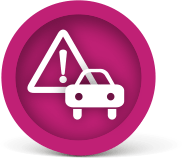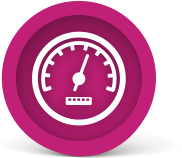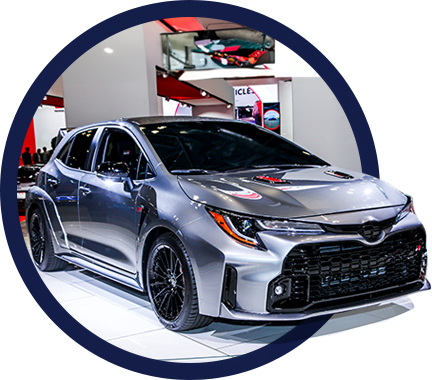
Car
INSURANCE

High-Risk
INSURANCE

Telematics
INSURANCE
Cheapest Ontario Car Insurance Premiums
Why isure gives you the best car insurance rates
As Ontario’s leading car insurance broker, isure provides quality coverage and the lowest Ontario car insurance rates, as well as convenient, personalized service. Whether you’re a preferred, standard, or high-risk auto insurance client, we’ll be there to help you save premiums along the way by comparing car insurance rates across Ontario.

Our Ontario car insurance brokers provide you fast, friendly and cheaper insurance on your car. We want to ensure that you aren’t surprised by the fine print in your policies or a short-term discount only used to win your business. If your auto insurer tries that, we will look into another insurer for you!
We compare the largest selection of isure-approved insurer in the market.

Our Ontario car insurance brokers provide you fast, friendly and cheaper insurance on your car. We want to ensure that you aren’t surprised by the fine print in your policies or a short-term discount only used to win your business. If your auto insurer tries that, we will look into another insurer for you!
Let us do the shopping to find you the best Ontario auto insurance rates and coverage in marketplace!
We compare the largest selection of isure-approved insurer in the market.
isure across ONTARIO
isure across Ontario

isure Car Insurance by Car Brand
isure Auto Insurance means:

Control Over Your Policy
LEARN MORE

Personalized Attention

Insight and Attention

iSavings

Responsive Claims

Guilt-free Quoting Process
AVERAGE COST OF CAR
INSURANCE IN ONTARIO
According to 2020 estimates from the Insurance Bureau of Canada, the average cost of a car insurance policy for an Ontario driver is $1,655. As with everything else in Ontario, insurance is expensive. On average, Canadian insurers are paying out as much in claims as they’re earning in revenue. Insurance fraud, increasingly severe weather, and a handful of secondary factors have raised the cost of insurance in Ontario over the last two decades. However, the auto insurance industry has been experiencing a dip in the cost of premiums over the past few years. Let’s examine some of the reasons:
As of December 2021, the average Ontario car insurance premium dropped to $1,555 annually or $129.60 per month. This is a 3.8% decrease from 2020. Auto insurance prices were going up for years in Ontario. The arrival of COVID-19 and its rapid spread across the globe brought with it immediate changes to drivers. The Financial Services Regulatory Authority of Ontario (FSRAO) has approved more than 100 rate reductions and 42 various rebates during the pandemic.


The largest overall decrease in auto insurance premiums in Ontario within the last five years was caused by several factors, but especially:

Professionals using their cars less while working from home

Insurance providers offering relief measures through lowered rates and rebates


Decreases in the number of vehicles on the road led to price decreases. Less cars on the road means fewer accidents and insurance claims, translating into better profits for insurance companies and savings for you. Looking forward to the rest of 2022, experts are uncertain about the direction rates will take. FSRAO says the lower rates won’t last forever, as it’s expected when the pandemic ends and driving habits return to normal that premiums will start to creep back up.
The largest overall decrease in auto insurance premiums in Ontario within the last five years was caused by several factors, but especially:

Professionals using their cars less while working from home

Insurance providers offering relief measures through lowered rates and rebates


Decreases in the number of vehicles on the road led to price decreases. Less cars on the road means fewer accidents and insurance claims, translating into better profits for insurance companies and savings for you. Looking forward to the rest of 2022, experts are uncertain about the direction rates will take. FSRAO says the lower rates won’t last forever, as it’s expected when the pandemic ends and driving habits return to normal that premiums will start to creep back up.

What factors affect Auto Insurance costs in Ontario?
Ontario drivers are required to have car insurance, and it is the law to have an active auto insurance policy before you get behind the wheel of your car. Residents in Ontario can rely on our brokers here at isure for car insurance, and we will do everything we can to provide you with the lowest rate possible.
In addition to fair car insurance rates, we also take the time to discuss our client’s needs. We will provide you with a clear understanding of your rate and the factors we look at when calculating your auto insurance premium.
Get the leading Ontario insurance policies with the best personalized options you deserve.
Wondering what factors affect car insurance
costs in Ontario?
Here’s what you need to know:

The make and model of your vehicle

Driving experience and insurance history

Age

Postal code

Driving record
ONTARIO CAR INSURANCE
FAQ’s
Are you required to have car insurance in Ontario?
If you drive a vehicle in Ontario, it is the law to have car insurance. Each province will require a certain minimum amount and may require specific additional coverage.
What affects my rate(s)?
Every driver needs auto insurance; however, rates will vary from person to person. There are several factors that will affect your rate, and the insurance company will also consider several details as any risks to determine your personal insurance profile.
It is the combination of these factors that will ultimately determine the rate you receive, and the following are the factors that will affect this aspect:
Your personal information
Everything from the type of vehicle you drive to where you live will be considered, as will your driving record, age, gender, and marital status. The make and model of your car will be factored in, and any previous accidents, the length of time you’ve been licensed, and any speeding tickets will also be considered. Additionally, those with a good driving record will most likely receive a lower premium. If you live in an urban area, your auto insurance rates will be higher as there is more risk of accidents and car theft in these areas. Insurance companies find that mature drivers have fewer accidents than younger drivers, so premiums will generally drop after the age of 25.
The amount you drive
Your insurance company may also consider whether you commute to work or school because rates are calculated based on the number of kilometres you drive. The more you drive, the higher your rate may be.
The amount of coverage you purchase
There is a certain amount of coverage that is mandatory however, you can buy additional protection, which would increase your rate. Increasing your third–party liability protection or your standard accident benefits coverage and/or purchasing comprehensive coverage to protect against theft are all examples of additional coverage that could increase your rates.
The deductible you select
This is the portion you will have to pay if you ever make an auto insurance claim. Insurance companies often offer separate deductibles for collision, comprehensive, all-perils, specific perils, and direct compensation-property damage coverages. The lower your deductible, the higher your premiums will be, and the higher your deductible, the lower your premiums will be.
Your insurance company
You must do your research because auto insurance premiums can vary from one company to another. That’s where isure steps in to shop the rates for you! Statistics will always be used to determine the financial costs of risk and uncertainty, and your personal profile will make a difference. However, you will still find that rates will vary from one insurance company to the next. Contact an auto insurance broker to help you find the company with the best rates.
How much does car insurance cost in Ontario?
As mentioned above, there are many factors that go into the price of car insurance in Ontario. Your quote can fluctuate depending on whether you require high-risk insurance, if you live in a city or, as an example, you can receive a lower quote if you practice safe driving and/or you bundle your policy. Go–telematics is also an option for great drivers as it tracks how you drive (speed, braking, cornering, etc.) to determine your rate.
How much does a car insurance quote cost?
Absolutely free! It is also very easy to get a car insurance quote in Ontario. Get started now by clicking here.
What does it mean to be at-fault in a car accident?
You’ll undoubtedly begin hearing the word “fault” a lot if you’re involved in a car crash. The other person may accuse you of being at-fault for the collision as soon as it occurs. Your isure broker will also be discussing it with you when making a claim. Fault counts if you are the cause of the accident. This means you’ll be responsible for other drivers’ expenditures (or, more accurately, your auto insurance company). We address your queries about being at-fault in an accident below.
What does “at-fault” mean?
When you are “at-fault” for an automobile crash, you are basically to blame for the accident (in simple terms). Regarding car accident-related auto insurance claims and personal injury lawsuits, the at-fault driver is the negligent driver. You will be considered at-fault if you do something (or fail to do something) that causes an accident. Examples of driver negligence include:
- Speeding
- Texting while driving
- Rear-ending another car
- Driving while under the influence of alcohol
- Driving in the wrong or opposite direction of the road
- Failing to maintain your equipment
- Violating a pedestrian’s right of way
- Crashing into some obstacle (no other car involved)
How to prove who’s at-fault for car accidents
Car insurance inspectors (and attorneys if you end up in court) generally consider the traffic regulations, legal rules of the road, and other evidence when determining or disputing who is at-fault after an automobile crash occurs. Examples of this evidence include:
- The other driver’s confirmation
- Eyewitness testimony from spectators
- A police report made at the accident site
- Videos and images of the accident scene
- Road debris and skid marks
- The extent and make of the automobiles damaged
If I am at-fault, how will my insurance be affected?
Losses brought on by an automobile accident are intended to be covered by your auto insurance policy. However, the specifics of what is covered varies, depending on your policy choice and the province in which you reside.
Your liability insurance will pay for the injured party’s medical expenses associated with their automobile crash injuries, economic damage (lost salary, reduced income potential), and “physical deterioration.” This includes bodily pain up to the limit values of your insurance plan if you are found to be at-fault for the collision.
Most provinces require liability insurance (or some form of financial responsibility evidence). Your accident insurance will typically pay for your damage, but to what extent depends on your coverage.
How to get reimbursement in at-fault accidents
The car insurance provider of the at-fault driver will be informed of the necessary payments for their at-fault driver after a claim is submitted. The other driver’s insurers may consent to pay out a one-time fee, and you’d have to agree to waive any subsequent claims.
If you successfully present your case in a lawsuit alleging an injury, you may be awarded the proper amount of damages by the court.
After filing a lawsuit, the issue is resolved in several cases before it goes to trial. A skilled vehicle accident attorney can assist you in negotiations or take your case to court if necessary to obtain the money you are entitled to.
What is the claim process after a car accident?
If you are ever involved in a car accident, you will have to go through a claims process, and understanding the steps that are involved will ensure you get the best possible outcome for your particular situation. Here at isure, we will help you get through this process as efficiently and easily as possible, aiming to provide you with all the necessary information you’ll need.
We care about our clients and offer them the protection they need. We highly recommend that you take the time to review your policy with us because knowing your rights, coverages and responsibilities will help guide you in the right direction. You have to file a report with isure within one week of the accident occurring so that your claim can be honoured. Simply put, you will have to provide your policy number, accident details and the make, model, year and licence plate number of your vehicle that was involved. You will also have to include the time, date and location of the accident, along with the number of passengers involved and the extent of any injuries.
Once you report the accident, we will then determine fault. It’s important to note that it’s possible for this aspect to be shared between several parties involved in the accident. If you are found at-fault, this information will be recorded on your insurance record, and there’s a high likelihood that your premium will increase whenever you renew your policy. If you disagree with our assessment of the situation, we will gladly provide you with more details so that you understand how we came to this conclusion.
In terms of compensation for a damaged vehicle, this will depend on the extent to which you are at-fault for the damage, and you will be compensated according to this information. The type of insurance coverage you have will also affect the amount you receive.
If any of this information feels overwhelming or if you have any questions regarding our claims process, do not hesitate to reach out to isure for more details.
Do I need to insure my car?
The answer is YES! It’s the law. You can be fined up to $5,000 and have your license suspended for driving without insurance. We know that legal stuff isn’t fun, but it’s essential. Car accidents happen, and if you’re involved in one, you can get stuck with an expensive bill for repairs. If someone else is at-fault, having car insurance protects you from paying those costs out-of-pocket.
Contact a car insurance broker like isure today.
How does where you live affect your car insurance premium?
Premiums are lower in rural areas because there are fewer risks of accidents than in urban environments. If you live in a city, you’re more likely to have an accident and pay more for insurance. So it might be worth your while to check out the rates in the surrounding towns.
Location matters because it’s an integral part of your risk profile. It includes factors, such as:
- Traffic congestion and accident likelihood
- Severity of local weather and the cost of damage caused by storms
- Crime rates—auto theft and vandalism
You may not be able to change your location, but you can learn how different areas around you can affect insurance prices for others.
Why should I choose an insurance broker?
Car insurance quotes are always changing in Ontario. Going through every insurance company by yourself can be time-consuming and stressful. When you work with an isure insurance brokerage, you will be able to easily compare quotes from our 25+ isure–approved insurers. We will also help you choose the best policy for your needs.
How can you get the cheapest auto insurance premiums?
The cost of car insurance is a significant concern for many consumers. Car insurance is a necessary purchase, but it doesn’t have to cost an arm and a leg. There are lots of ways that you can make your coverage more affordable. Here are some things that you can do to pay less for car insurance:
Shop around
Not all auto insurers are alike, and there are significant differences in their prices. Consider having isure speak with several providers before choosing a policy.
Raise your deductible
Your deductible is the amount you agree to pay out-of-pocket before your insurer pays anything toward a claim. Raising your deductible may mean higher out-of-pocket costs when you need to make a claim, but it will reduce what you pay each month.
Drop unnecessary coverage
If you drive an older car or one with high mileage, consider dropping collision and/or comprehensive coverage from your policy. These coverages only apply when you cause damage to your vehicle. They aren’t worth as much as they cost if your car is old or isn’t worth very much money.
What is No-Fault Car Insurance?
Contrary to popular belief, no-fault insurance does not mean that you can never be found at-fault for a car accident. Instead, it refers to how your insurance company will pay out your insurance claim. For a traditional auto insurance system, the at-fault driver’s insurance company will be responsible for issuing payment for damage to both vehicles that are involved in the crash. But under a no-fault insurance policy, this is not the case.
How does a no-fault insurance policy work?
Under a no-fault auto insurance policy, the parties involved in the collision will both file and settle claims using their respective insurance companies, regardless of who was at-fault for the collision.
One of the most important terms found in a no-fault policy is direct compensation property damage or DCPD. Many people misunderstand DCPD and believe that it is a no-fault system, however, DPCD is not a no-fault. You may only claim against the DCPD section of your property to the extent that you are not at-fault.
To put it in simpler terms, DCPD will be the part of your insurance policy that covers damage to your vehicle when you are found not at-fault for a collision. If you are found at-fault, the damage will only be covered if you also have collision coverage or all-perils coverage.
In this scenario, you will still need to pay your collision deductible. But your insurance company will not need to pay for the damage that was caused to the other driver’s vehicle. When you are under a no-fault policy, you will receive full medical and rehabilitation benefits through your own insurance company. You may also be entitled to an income replacement benefit as well as others, but this will depend on how serious your injuries are. This model eliminates financial compensation for pain and suffering.
One major perk of driving with a no-fault policy is that your claim will usually get resolved quickly, which means you will receive compensation sooner. And, you won’t need to worry about dealing with both insurance companies, just your own. It will help to simplify the claims process for you!
Which specific Canadian provinces operate under a no-fault system?
There are currently only six provinces operating under a no-fault insurance system:
- Ontario
- Nova Scotia
- New Brunswick
- Quebec
- Prince Edward Island
- British Columbia
Drivers located in Saskatchewan will have the choice to opt-out of the province’s own no-fault insurance policy, and pick coverage under the tort system instead. This will allow them to sue for pain and suffering with a $5000 deductible.
How do different traffic tickets affect auto insurance?
Traffic tickets will affect your auto insurance rates, although the outcome of each case will be different, based on the type of ticket you receive.
Traffic tickets are divided into three categories:
- Minor
- Major
- Serious convictions
Each of these can affect your policy and your rate, regardless of the number of demerit points or the severity of the fine that is associated with your infraction. However, the way in which your insurance is affected will be based on the type of conviction.
Driving uninsured, failing to remain at an accident, racing or a DUI are all examples of serious convictions. In contrast, distracted driving, improper passing of a school bus and failure to report an accident are examples of a major conviction. Backing up unsafely or illegally opening your door would be considered minor convictions, so it’s important that you understand the distinct types of tickets.
In addition to demerit points, driving under the influence can include criminal charges, jail time and a license suspension. Distracted driving would also result in large fines, as well as several demerit points. If you get caught driving without insurance, it would be difficult and expensive to get insurance in the future. Another example of a serious offence that would automatically increase your insurance rate is speeding.
Every insurance company has their own policies regarding how they charge for driving convictions, and the potential impact of your conviction can be minor or severe. A percentage system is used, and serious or criminal convictions will cause you to be charged 100% more for each conviction, whereas major convictions will cause you to be charged 25% more for each conviction. One minor conviction may not have an impact on your insurance, whereas two or more minor convictions will result in charging you 20% more.
If you are wondering whether parking tickets impact insurance, you will be happy to know that they do not. However, it is important that you pay these parking tickets on time, otherwise, you will not be allowed to renew your license plate when it is time for renewal.
Speeding tickets are also quite common, which can impact your car insurance. Its effect will depend on the severity of the speeding ticket and how fast you were going over the speed limit. If you have several speeding tickets, this will also negatively affect your insurance. Your first minor speeding ticket may not have as much of an impact on your insurance as say, a third speeding ticket.
Types of Auto Insurance Coverage (Mandatory Coverage)
The different categories for Ontario auto insurance coverage plan include:

Liability Insurance
LEARN MORE

Emergency Road Service

Comprehensive Insurance

Collision Insurance
isure Optional Coverages for Auto Insurance
Customize your Car Insurance plan to suit your unique needs and preferences with Optional Coverages.
Accident Forgiveness

Your Possessions Saved

Physical Damage to Your Car
Third Party Automobile Liability
Accident Benefits Coverage
Rental Car Coverage

Speak to an Insurance Broker

Compare Car Insurance Quotes Online
HOW INSURANCE WORKS IN ONTARIO
In Ontario, the FSRA (Financial Services Regulatory Authority of Ontario) outlines stringent regulations governing auto insurance coverage from private insurance companies. Businesses must adhere to a uniform auto policy set forth by the regional government. Responsibility, disaster benefits, uninsured motorist protection, and DCPD (Direct Compensation For Property Damage) are always included. Collision, comprehensive, and other endorsements are also available. The Ontario winter tire discount is a good perk in terms of financial savings!
Ontario was one of the initial provinces to authorize consumer insurance coverage, often known as ‘compensation insurance’. If you drive less, UBI (Usage-Based Insurance) or “Telematics” may enable you to lower your auto insurance expenses. Additionally, it acknowledges your abilities as a driver. However, a recent revision to the Ontario UBI regulations implies that reckless driving is also punishable. If you are outside of Ontario for longer than six months with your car, you will have to set up a separate insurance policy, no matter the reason.

WHICH CITIES IN ONTARIO
HAVE THE MOST EXPENSIVE
CAR INSURANCE?
According to proprietary data, the cities with the most
expensive yearly rates are all part of the GTA. Vaughan
has the most expensive car insurance rates, on average,
followed by Ajax, Richmond Hill, Brampton, Mississauga,
and Pickering. The full list is included below:
2. Ajax: $2,104
3. Richmond Hill: $2,025
4. Brampton: $1,976
5. Mississauga: $1,971
6. Pickering: $1,959
7. Toronto: $1,953
8. Oshawa: $1,833
9. Whitby: $1,792
10. Nobleton, Schomberg, Orangeville,
King City: $1,766
WHICH CITIES IN ONTARIO
HAVE THE CHEAPEST
CAR INSURANCE?
cheapest insurance are:
Ajax: $2,104 2.
Richmond Hill: $2,025 3.
Brampton: $1,976 4.
Mississauga: $1,971 5.
Pickering: $1,959 6.
Toronto: $1,953 7.
Oshawa: $1,833 8.
Whitby: $1,792 9.
Nobleton, Schomberg, 10.
Orangeville, King City: $1,766
Formerly number four on the list, Vaughan’s average annual premium was $2,334 in 2020. While Vaughan moved up to the top of the rankings, it still saw a decrease of 6.67%. Vaughan is comprised of Woodbridge, Thornhill, Concord, Kleinburg, and Maple.
Conversely, Brampton, which has long held the title as the most expensive city in Ontario to insure a car, saw the largest decline in premiums of 27%. Its drop in ranking may be due, in part, to the City of Brampton approving a motion last March to lobby the province to end “postal code discrimination.” This is referring to the practice of insurance companies pricing premiums based on overall claims frequency in a given geographic area rather than by individual driving behaviour.
There is a difference of $1,047 between the least to the most-costly premiums province-wide. All cities on the above list pay about $400 less per year than the 2021 Ontario average of $1,555.
In an interesting development, RATESDOTCA reports that though the drivers from the above places pay the least in premiums, they saw their insurance rates go up year-over-year (with the exception of the village of Kendal, where rates decreased by 7.6%). Historically, insurance companies say that auto insurance tends to get cheaper the further you are from Toronto and its surrounding suburbs. For the most part, this remains to be true…with some exceptions. Typically, theft and accidents are less common in smaller, less-populated cities, which plays a big part in rates. However, due to the pandemic, the smaller cities cited above saw an increase in their population. This may prove to be in part because of remote work people moving further out of Toronto. This will result in an increase of cars on the road. Experts are studying data to be able to conclude that definitively.

Ontario Car Insurance Vs Other Provinces
The way that various jurisdictions provide insurance coverage to their drivers is just one of the many variables that affect auto insurance costs across Canada. The nation is home to both publicly and privately-managed auto insurance programs.
For instance, Saskatchewan, Manitoba, and British Columbia depend on a provincially-managed range, whereas most of the nation relies on private insurance coverage provided by various independent insurance providers.
Because rates are driven down by market competition, private car insurance rates have generally become the most economical alternative in Canada. Let’s take a detailed look below.
Car insurance in Quebec vs. Ontario
Of all Canadian provinces, Quebec has the cheapest insurance prices. The rate of increase is slower in comparison to Ontario because the province’s insurance laws are less stringent than those in other provinces. In Quebec, combining private and public insurance enables additional coverage to standard insurance plans. Accident liability is restricted by the no-fault system, which also lowers the overall cost of insurance.
Ontario Car Insurance vs. Saskatchewan Car Insurance
Car insurance is required by law for every driver in Canada. However, the province you live in will dictate your auto insurance coverage requirements.
Here at isure, we will help you find the best insurance policy rates for your needs, and our brokers will do everything they can to provide you with the lowest rates possible. We are happy to discuss your unique needs and circumstances to help you find the best policy. We want our clients to have a detailed understanding of their car insurance policy, including the requirements their province has in place. This guide will highlight key information specific to drivers in both Ontario and Saskatchewan.
Mandatory car insurance requirements in Ontario:
1. Third-Party Liability
Third-Party Liability coverage will protect you if you are responsible for causing injury or damage to another person or their property while driving. In Ontario, the minimum coverage amount required by law is $200,000.
2. Accident Benefits Coverage
This coverage will benefit you and your passengers if involved in a car accident, which will apply, regardless of who was at-fault. Medical expenses, rehabilitation costs and loss of income will be included in this coverage.
3. Direct Compensation/Property Damage Coverage
If you are involved in an accident with another driver who is at-fault and their insurance is inadequate or uninsured, you will be protected due to this type of coverage.
Mandatory car insurance requirements in Saskatchewan:
1. Third-Party Liability
This will protect you in the event that you injure someone or damage someone else’s property. All drivers in the province are required to carry third-party liability insurance of up to $200,000.
2. Accident Benefits
This portion of your coverage will pay for injuries due to a traffic accident, similar to Ontario.
3. Uninsured Automobile
If the other driver is at-fault but has no insurance, this portion of your policy will cover your repair costs.
Drivers in Saskatchewan will generally pay less for car insurance than drivers in Ontario. However, the province operates on a provincially-run auto insurance agency, which means drivers must pay what the Saskatchewan Government Insurance mandates.
Car insurance brokers you can trust
Are you in need of car insurance? Do you want the best rates possible? It’s time to contact our brokers here at isure! Our team consists of knowledgeable and professional car insurance brokers who are passionate about helping clients. We will calculate your car insurance rate and discuss details specific to your case, based on your needs.
Contact us today for all of your auto insurance needs! Speak with an isure broker today: 1-877-689-2957.
Car Insurance in Manitoba vs Ontario
Ontario Car Insurance
The most populous of all the provinces, Ontario is the second most expensive province when it comes to car insurance. Drivers should not expect cheap rates compared to what drivers in Manitoba will pay. Rampant fraud, population density, traffic congestion, accident rates and the frequency of claims are just some of the reasons why Ontario drivers have to pay such expensive auto insurance rates.
In Ontario, drivers are required to have a minimum of $200,000 in third-party liability coverage along with accident benefits coverage, direct compensation property damage coverage and uninsured automobile coverage.
Manitoba Auto Insurance
Drivers in Manitoba can expect to pay less for car insurance than drivers in Ontario. However, this province has a crown corporation issuing car insurance, which means negotiating and shopping around for quotes will not work. Unfortunately, there’s not much drivers in Manitoba can do if they’re unhappy with their car insurance rate. However, you can work on lowering this amount by focusing on the factors within your control. For example, you can bundle your car and home insurance, which will likely result in a discounted rate.
Car insurance in British Columbia vs. Ontario
The state of British Columbia has the highest median insurance premiums. Since a crown business manages its insurance, there is no way to compare prices and save money. Although BC has a break-even profit scheme, operational expenses sometimes exceed revenues. The Insurance Group of British Columbia lowered prices by about 20% in the spring of 2021.
Car insurance in Prince Edward Island vs. Ontario
Private car insurance is the primary source of coverage in Prince Edward Island, keeping costs low for extended periods. Additionally, PEI has one of the lowest collision rates in the country, especially compared to Ontario—meaning there are fewer claims to settle. One of Canada’s most influential, privatized auto insurance programs is found in PEI. Due to competition and declining annual auto insurance claims, rates are still low.
Car insurance in Newfoundland and Labrador vs. Ontario
Suppose you are looking for the best insurance policies in Ontario or looking forward to joining hands with reliable insurance brokers; that’s where isure steps in. Contact our knowledgeable insurance brokers today to help you find the best rates and coverage for your specific insurance needs. We work with the top companies and can “shop” on your behalf to obtain the best premiums and coverages for your peace of mind.
Ontario Car Insurance vs. Alberta Car Insurance
Every driver needs car insurance, and our team here at isure will help you find the best auto insurance policy for your specific needs. The province you live in will affect the type of car insurance you require. The following guide will compare car insurance information for drivers in both Ontario and Alberta.
Insurance coverage
Each province has a different mandatory minimum insurance coverage requirement. In Alberta, drivers must have a minimum of $200,000 in third-party liability coverage. In contrast, drivers in Ontario need to have a minimum of $200,000 in third-party liability coverage AND accident benefits coverage, direct compensation property damage coverage and uninsured automobile coverage.
Premiums
Car insurance premiums tend to be lower in Alberta because of factors like population density, accident rates and the cost of repairs. Drivers in Ontario should typically expect to pay more.
The car insurance brokers at isure will assess your needs, your driving record and your circumstances to discuss the policy that will be best for your specific situation. The cost of auto insurance will vary depending on the province, although we will suggest any potential savings and discounts directly to you, our clients. We will review the specifics of your policy and discuss all of the options available to you. This will, in turn, help us find you the best rate possible.
We provide our clients with honest information. Ontario car insurance rates are among the highest in Canada. Auto insurance in Alberta is generally cheaper, and traffic congestion contributes to this difference in rates, as does the frequency of claims. Other factors, however, will also affect your car insurance rate, including your age, driving record and the make and model of your vehicle.
Car insurance rates may be cheaper in Alberta than in Ontario, but the specifics of your coverage and the rate you receive will vary depending on your unique circumstances. We discuss every detail to ensure you have a clear understanding of your rate and how it was calculated.
Minimum Requirements in Ontario
In Ontario, the minimum required car insurance coverage includes:
1. Third-Party Liability Coverage
This coverage will protect Ontario drivers if they are responsible for causing injury or damage to another person or their property while driving. The minimum coverage required by law in this province is $200,000.
2. Accident Benefits Coverage
AB coverage will provide both you and your passengers with benefits, regardless of who is at-fault. This coverage includes medical expenses, rehabilitation costs and loss of income.
3. Direct Compensation/Property Damage Coverage
DCPD coverage will protect you if you are involved in an accident with another driver who is at-fault with inadequate coverage or is uninsured.
Minimum requirements in Alberta
In Alberta, the minimum requirement for car insurance coverage includes the following:
1. Third-Party Liability Coverage
This will protect Alberta drivers if they are responsible for causing injury or damage to another person or their property while driving. The minimum coverage required by law in this province is $200,000.
2. Accident Benefits Coverage
This will benefit you and your passengers if you get into a car accident, regardless of who is at-fault. This coverage includes medical expenses, rehabilitation costs and loss of income.
3. Uninsured Automobile Coverage
You are protected with this coverage if you are involved in an accident with an uninsured or under-insured driver.
Our isure brokers are always ready to help, and you can contact us anytime for more information regarding car insurance in Ontario.
Give us a call today at 1-877-689-2957 to discuss your auto insurance needs!
Car insurance in Yukon vs. Ontario
Every driver needs car insurance, and our team here at isure will help you find the best auto insurance policy for your specific needs. The province you live in will affect the type of car insurance you require. The following guide will compare car insurance information for drivers in both Ontario and Alberta.
Insurance coverage
Each province has a different mandatory minimum insurance coverage requirement. In Alberta, drivers must have a minimum of $200,000 in third-party liability coverage. In contrast, drivers in Ontario need to have a minimum of $200,000 in third-party liability coverage AND accident benefits coverage, direct compensation property damage coverage and uninsured automobile coverage.
Premiums
Car insurance premiums tend to be lower in Alberta because of factors like population density, accident rates and the cost of repairs. Drivers in Ontario should typically expect to pay more.
The car insurance brokers at isure will assess your needs, your driving record and your circumstances to discuss the policy that will be best for your specific situation. The cost of auto insurance will vary depending on the province, although we will suggest any potential savings and discounts directly to you, our clients. We will review the specifics of your policy and discuss all of the options available to you. This will, in turn, help us find you the best rate possible.
We provide our clients with honest information. Ontario car insurance rates are among the highest in Canada. Auto insurance in Alberta is generally cheaper, and traffic congestion contributes to this difference in rates, as does the frequency of claims. Other factors, however, will also affect your car insurance rate, including your age, driving record and the make and model of your vehicle.
Car insurance rates may be cheaper in Alberta than in Ontario, but the specifics of your coverage and the rate you receive will vary depending on your unique circumstances. We discuss every detail to ensure you have a clear understanding of your rate and how it was calculated.
Minimum Requirements in Ontario
In Ontario, the minimum required car insurance coverage includes:
1. Third-Party Liability Coverage
This coverage will protect Ontario drivers if they are responsible for causing injury or damage to another person or their property while driving. The minimum coverage required by law in this province is $200,000.
2. Accident Benefits Coverage
AB coverage will provide both you and your passengers with benefits, regardless of who is at-fault. This coverage includes medical expenses, rehabilitation costs and loss of income.
3. Direct Compensation/Property Damage Coverage
DCPD coverage will protect you if you are involved in an accident with another driver who is at-fault with inadequate coverage or is uninsured.
Minimum requirements in Alberta
In Alberta, the minimum requirement for car insurance coverage includes the following:
1. Third-Party Liability Coverage
This will protect Alberta drivers if they are responsible for causing injury or damage to another person or their property while driving. The minimum coverage required by law in this province is $200,000.
2. Accident Benefits Coverage
This will benefit you and your passengers if you get into a car accident, regardless of who is at-fault. This coverage includes medical expenses, rehabilitation costs and loss of income.
3. Uninsured Automobile Coverage
You are protected with this coverage if you are involved in an accident with an uninsured or under-insured driver.
Our isure brokers are always ready to help, and you can contact us anytime for more information regarding car insurance in Ontario.
Give us a call today at 1-877-689-2957 to discuss your auto insurance needs!
DRIVING IN ONTARIO
Our insurance brokers here at isure can provide you with the best auto insurance policy for you. We provide all of our clients with detailed information and the best rates
We’ve also created the below guide about driving in Ontario to further help our clients with important information about driving in this province:
Requirements to drive in Ontario
- Individuals in Ontario must be at least 16-years-old and have a valid Ontario driver’s licence to drive in this province.
- You must first pass your written test, or G1 licence. You’ll then need 12 months of experience on the road to obtain your G2, which is a probationary license. Following that, once you gain one year’s experience, you can apply for your G, which is a full licence.
- Visitors to Ontario who want to drive must be at least 16-years-old and have a valid driver’s licence from their state, country or province. Anyone visiting Ontario for more than three months will need an International Driver’s Permit from their own country.
- New residents with a valid driver’s license from another province or country can use their license for 60 days after their move to Ontario.
- Once you become a permanent resident of Ontario, you will have to obtain an Ontario driver’s license.

Major highways in Ontario
- Highway 401 is the busiest highway, not just in Canada, but in all of North America. This highway runs through Toronto and has express and collector lanes. Depending on the time of day, this highway can become quite congested.
- Along the south end of Toronto and through downtown lies the Gardiner Expressway. This highway provides drivers with direct access to downtown Toronto. This runs into the Don Valley Parkway, which can take drivers back to the 401.
- Highway 427 connects the Gardiner Expressway to the 401, near Pearson International Airport.
- The 401 to the north, the 427 to the west, Don Valley Parkway to the east, and the Gardiner Expressway to the south, form a box around Toronto.
10 Most Popular Cars in Ontario

Volkswagen Golf
In addition to efficiency and an iconic design, you will enjoy affordable car insurance rates with this Volkswagen.
volkswagen.ca

Nissan Sentra
Its inexpensive price tag and cool appearance have led this car to become one of the top-selling vehicles in Ontario.
nissan.ca

Mazda 3
This beautiful-looking car is slick, fun to drive and is perfect for buyers who want aesthetics, but have a small budget to work with.
mazda.ca

Toyota Camry
This car is available in an extremely fuel-efficient, four-cylinder model. It has a powerful V6 and an eco-friendly hybrid, so there’s something for everyone. This is why it is one of the most popular cars in Ontario.

Volkswagen Jetta
This is a fun car with a spacious cabin and an updated infotainment system, so there is a lot to love!
volkswagen.ca

Tesla Model 3
Those willing to pay a little more will love this Tesla model because it offers drivers the peace of mind of all-wheel drive. You will get 576 km per charge, and this specific Tesla can go from 0-100km/h in 3.3 seconds. Learn more about car insurance for electric vehicles.
tesla.com

Kia Forte
The Forte will provide you with great fuel consumption and easy driving. You will enjoy its affordable price tag, which is why it’s no surprise that the Kia Forte is a bestseller.
kia.ca

Hyundai Elantra
This car is also quite affordable and features a touchscreen that will work with Apple CarPlay and Android Auto. The Sport model features a very strong 201 horsepower engine!
hyundai.ca


Honda Civic
With plenty of models and prices to choose from, the Honda Civic is one of Ontario’s best-selling cars and has remained one of the top sellers for several years.
honda.ca
Get a FREE
non-obligation
insurance quote
Insure Peace of Mind with isure:
Ready to experience the isure difference? We’ll be your trusted companion on the journey to insurance savings, adequate coverage and peace of mind. Get the expert guidance you need with our friendly support staff. We’ll help you compare quotes and coverage options from Canada’s top insurance providers.
Embark on the path to savings with isure by your side!
Get a Quote
OUR LATEST iNEWS BLOG
Electrical Damage: Is it Covered by Your Policy?
Most home insurance policies in Ontario may cover electrical damage, but only to a certain extent. Each policy and provider is different. However, there are some instances in which electrical damage would be covered. So, in this article, let’s break down the cases in which home insurance would cover electrical damage.
Car Insurance and Travel: How to Stay Protected Abroad
Before you embark on your next great summer adventure, reviewing your auto policy is wise decision. To ensure you have the protection you need, let’s review some helpful tips for car insurance when traveling out of province and to the U.S.
Parking lot accidents: Can you make a claim?
Parking lot accidents are quite common. Due to this, they should be treated similarly to how an accident on the road would be treated.




















